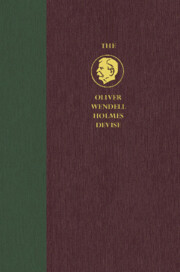Book contents
- The Hughes Court
- The Oliver Wendell Holmes Devise History of the Supreme Court of the United States
- Additional material
- Additional material
- The Hughes Court
- Copyright page
- Contents
- Acknowledgments
- Preface
- Table of Cases
- Introduction
- Part I The Opening Years
- Part II Continuities
- Section A: Administrative Law
- Chapter 19 Envisioning Administrative Law
- Chapter 20 Constitutional Limitations on Agencies
- Chapter 21 The President’s Role
- Chapter 22 The Courts’ Role in Administrative Law
- Section B: Civil Liberties and Civil Rights
- Section C: Justiciability
- Part III New Approaches Begin to Emerge
- Historiographical Essay
- Index
Chapter 22 - The Courts’ Role in Administrative Law
from Section A: Administrative Law
Published online by Cambridge University Press: 13 January 2022
- The Hughes Court
- The Oliver Wendell Holmes Devise History of the Supreme Court of the United States
- Additional material
- Additional material
- The Hughes Court
- Copyright page
- Contents
- Acknowledgments
- Preface
- Table of Cases
- Introduction
- Part I The Opening Years
- Part II Continuities
- Section A: Administrative Law
- Chapter 19 Envisioning Administrative Law
- Chapter 20 Constitutional Limitations on Agencies
- Chapter 21 The President’s Role
- Chapter 22 The Courts’ Role in Administrative Law
- Section B: Civil Liberties and Civil Rights
- Section C: Justiciability
- Part III New Approaches Begin to Emerge
- Historiographical Essay
- Index
Summary
The Progressive vision of adminsitrative agencies began to be displaced by a pluralist account in which administrative agencies were locations for interest group struggle. The older vision remained strong and guided the Court’s approach to issues such as the standard of review in rate-making cases. The Court also condemned in overstated terms an SEC investigation into probably unlawful speculation by J. Edward Jones, but its decision made only modest inroads in agency procedures. More significant were the Morgan cases, which confirmed the importance to the Supreme Court of the fact that agencies used procedures closely resemeling judicial ones, though the Court allowed some deviations for purely judicial procedures. The chapter concludes with a discussion of the development of the Administrative Procedure, which codified much of what the Court had already done.
Keywords
- Type
- Chapter
- Information
- The Hughes CourtFrom Progressivism to Pluralism, 1930 to 1941, pp. 512 - 550Publisher: Cambridge University PressPrint publication year: 2022

